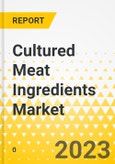This report comes with 10% free customization, enabling you to add data that meets your specific business needs.
The Cultured Meat Ingredients Market is experiencing a transformative shift in the food industry, as an increasing number of consumers and food companies seek sustainable and alternative protein sources. This report provides a comprehensive analysis of the Cultured Meat Ingredients Market, focusing on alternate protein sources, cell engineering techniques, and the barriers in the commercialisation of cultivated meat.
Introduction
Cultivated meat, also known as cell-based meat or lab-grown meat, represents a pioneering development in the food industry. It offers a sustainable and ethical alternative to traditional meat production by producing meat directly from animal cells. This report explores the ingredients and technologies that make this innovation possible.
Market Overview
This report provides an overview of the Cultured Meat Ingredients Market, emphasizing its current state and growth prospects.
Market Size and Growth
- Factors driving this growth include increased consumer demand for sustainable and cruelty-free meat products, advancements in cell engineering, and the expanding food-tech industry.
Alternate Protein Sources
- As the world seeks more sustainable protein options, cultivated meat ingredients offer a compelling solution.
- Plant-Based Proteins: Cultured meat can be produced using plant-based ingredients as a nutrient source for the cultivated cells, reducing the reliance on traditional livestock farming.
- Algae and Microbes: Algae and microorganisms can serve as a cost-effective and sustainable source of nutrients for cultivated meat, presenting opportunities for ingredient innovation.
Cell Engineering Techniques
- Cell engineering plays a crucial role in the cultivation of meat.
- Cell Isolation and Proliferation: Innovative techniques are being developed to isolate and proliferate animal cells efficiently, ensuring the scalable production of cultivated meat.
- Bioreactors: Bioreactors are essential for creating the optimal environment for cell growth, enabling large-scale meat production.
Barriers in the Commercialization of Cultivated Meat
- While cultivated meat holds promise, it faces significant challenges on its path to commercialization.
Regulatory Hurdles
- Labelling and Safety Standards: Regulations surrounding labelling, safety, and health standards for cultivated meat need to be established to ensure consumer trust and safety.
- Approval Processes: Streamlining regulatory approval processes is essential to enable the commercialization of cultivated meat products.
Cost and Scalability
- Cost-Effective Production: Reducing the cost of production is vital to make cultivated meat competitive with traditional meat products.
- Scaling Production: Scaling up production while maintaining quality and safety standards is a challenge that needs to be addressed.
Consumer Acceptance
- Cultural Acceptance: Consumer preferences and cultural acceptance of cultivated meat will be crucial for market success.
- Education and Awareness: Initiatives are needed to educate the public about the benefits of cultivated meat and dispel misconceptions.
This product will be delivered within 5-7 business days.
Table of Contents
Companies Mentioned
- AMSBIO
- Bright Biotech
- BioBetter
- Extracellular
- IntegriCulture Inc.
- Matrix F.T.
- SeaWith Inc.
- Sartorius AG
- Multus Biotechnology
- CELLULAR AGRICULTURE LTD
- Liberation Labs








